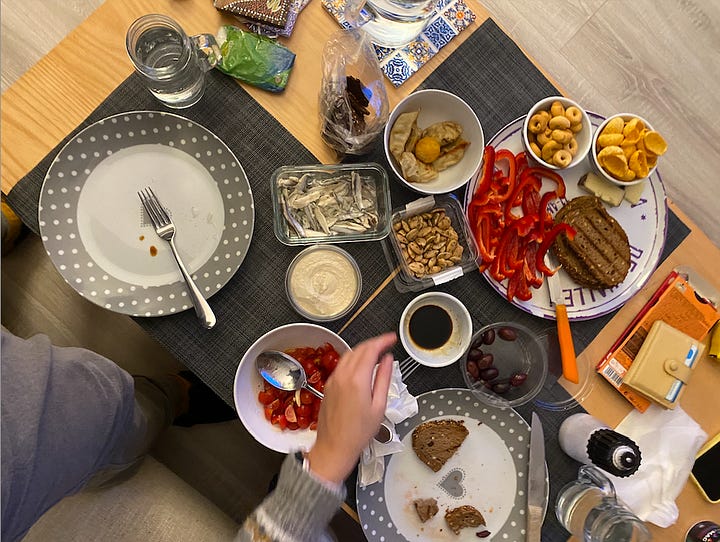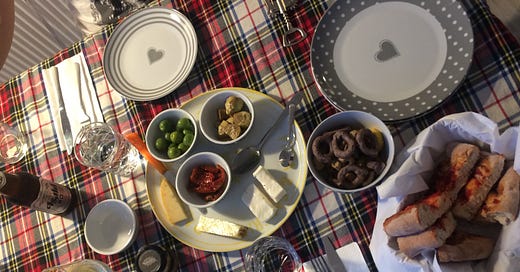Thank you for reading Beyond Survival, a publication about life after trauma. This edition is about how I feed myself when life is hard. It shares an approach that works for me, but I know might not work for everyone. Please trust your own instincts and seek medical advice if you need it.
When life is difficult, dinner often becomes just another task to be accomplished. It’s a question that needs an answer at the end of every day, and those answers require grocery shopping, food prep, clean up and, if you’re eating with someone who believes every meal is an occasion, setting the table.
When my partner and I were falling in love, she used to assemble lavish aperitivo boards for us to share. She’s Italian, a culture which celebrates food and the act of sharing it. During those lockdown days, when we couldn’t go out to eat, she’d set out a delicious array of cheese, dips and other treats. I always ate too much, stuffing myself on nibbles before the main event (usually pasta) even arrived at the table. We’ve maintained the habit of occasionally having what we think of as a smorgasbord dinner. It’s perfect for those days when my brain can’t bear to solve another problem.
Rather than trying to figure out a single, coherent meal, we assemble all the various odds and ends that are in the kitchen and eat whatever we like. It feels important to say that this is not a “girl dinner’ strategy. This is not about eating less, or skipping meals. This is about providing yourself with a symphony of flavours, and allowing yourself the sensory experience of trying lots of different things. The meal doesn’t need to make sense from a nutritional point of view. It doesn’t need to be made up of things we consider “dinner foods”. It just needs to be a selection of things you like.
Sometimes, the smorgasbord dinner approach is still too much for me. Sometimes, all I want is bland, beige food and an early night. But when I have a little capacity, assembling a tray of tasty things to eat feels like a small step toward recovery. It communicates abundance to my body. It reiterates that my body is worthy of something delicious. When your world has been shrunken down by grief or trauma, it’s a way to reach towards the vibrancy of life.
I don’t have children, but I know that one of the feeding strategies du jour is to provide children with a range of options at a set time and allowing them to eat whatever they’d like.1 Smorgasbord dinner feels like a similar approach - you provide yourself with a collection of options and see what resonates with you the most.
This approach requires work. I want to acknowledge that. It requires putting some thought into assembling a bunch of different things to eat, and having the money to pay for them. I would happily eat these things directly from their packaging, standing over the sink but my partner believes in setting the table and making each meal a moment. And you know what? She’s often right. Part of the appeal of this is the feeling that an extravagant spread has been laid out just for you. It’s hard for it to feel extravagant if you’re eating next to the bin.
There’s a balance though. Who wants to spend a half hour arranging things in nice bowls? I recommend that anything in the crisp/cracker family should go in a bowl, and that the bread should be pre sliced and maybe toasted/warmed if that’s what you like. I don’t mind eating directly from a tin of fish - it calls to mind the night my siblings and I split a tin of peaches as if we were on a desert island eating the last of our rations. Anything that needs to be put in a serving dish but which I don’t think we’ll finish goes in a tupperware that we can easily store in the fridge afterwards. There will be some washing up, but hopefully not too much more than usual.
The bigger task is seeking out yummy things to try. Living with an Italian, we always have a lot of cheese and yummy snacky things. But if you’re starting from scratch, it takes some time and money to build your basics. I recommend a trip to your local Aldi or Lidl where you can stock up on new-to-you nibbles. I always have an eye out for things that could work for smorgasbord dinner, like differently flavoured crisps or unique dips. It becomes a way of interacting differently with food in the supermarket, thinking not just of meals but of things that can be nibbled and devoured outside of the rigid confines of our eating routines. Don’t worry about whether things will go well together. Don’t worry about it being too much, or too “unhealthy” whatever that means. Just assemble a feast for yourself and eat what excites you.




I’ve included a few snapshots from recent smorgasbord dinners to get you thinking. Here are some suggestions for foods we often include:
Produce:
Grapes, mandarins or other small fruits/berries. So much of this food is rich and savoury, so I always end up eating a decent amount of fruit.
Chopped up peppers or carrots or another veg you like. (Hopefully the only chopping required for this meal!)
Guacamole if you’re feeling fancy. Or mashed avocado with lemon and salt if you’re not.
My partner often prepares a bruschetta topping. i.e. tomatoes dressed with olive oil, salt and sliced garlic (Be careful not to eat the garlic! 🤢)
Proteins:
Various cheeses - including at least one soft cheese. A baby food texture isn’t a problem here.
Tinned fish or, especially during summer time, smoked mackerel
A boiled egg or two
Nuts - pistachios are always a hit. (This dish was a game changer for us. Also great for olives.)
Marinated anchovies
Some store bought falafel heated slightly in the microwave (or air fryer/toaster oven/whatever you have)
If you’d like more dairy, cottage cheese or ricotta would work well.
From the pantry:
Jarred anchovies
Sundried tomatoes
Rice crackers (we like the sweet chili flavour)
Bombay mix
Crisps. Made with potatoes, chickpea flour, lentils or whatever else you feel like
Tortillas
Crackers, breadsticks and other crunchy bread products (A special shout out for taralli, a kind of circular cracker from Puglia, in Southern Italy.)
Focaccia or other bread. (Don’t skimp on the bread. It’s nice to have something simple to cut through the intensity of everything else.)
Sweets like M&Ms or chocolate covered nuts to break up all the savoury.
From the fridge:
Coleslaw or other salads from the supermarket salad bar
Hummus. Original or a new-to-you flavour.
Olive tapenade
Olives
Mustards - my partner loves truffle mustard!
A pre-made tortilla from the supermarket.
Whatever leftovers are in the fridge, either from things you cooked or had delivered. Gyoza and edamame are especially good.
If you enjoyed this, you might like to read another food essay. Here are two favourites:
💕 If this piece resonated with you, please tap the heart below to help spread the word.
💬 In the comments, I’d love to hear about the things you eat when you don’t feel like cooking.
✍️ Beyond Survival is written by me, Clare Egan, an award-winning writer and journalist. You can read more about me here, or look at some pretty pictures over here. Click reply to say hello anytime. Thank you for being here!
Virgina Sole-Smith has written about this approach and how it doesn’t work for every child.







As a disabled/spoonie person, this is something I do too, but I had never really thought about it until I read this post. Another thing that has helped, since I don't have a partner to help prepare things, is to get rid of the guilt of buying prepared dishes - things like pre-cut fruits, for instance. I had bought into the idea I was being lazy and wasteful for no reason, when really, I was just accommodating myself. I've been eating better since I've changed my mindset around that.
These are my favorite kinds of dinners. Small bites, lots of flavors and textures. Yum!